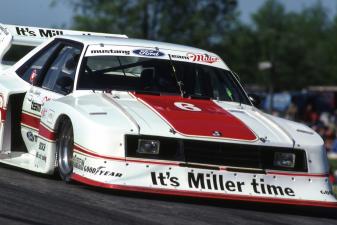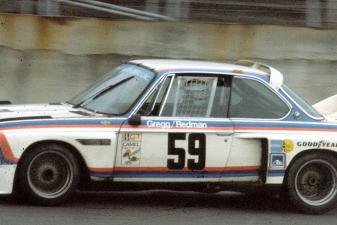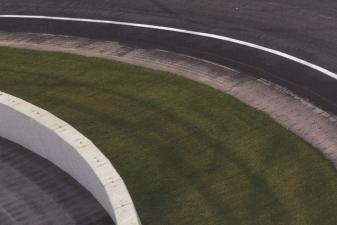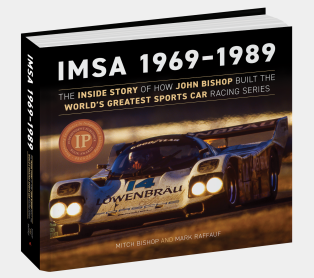The Real Story of How Turbos Arrived in IMSA
An excerpt from IMSA 1969–1989, by Mitch Bishop and Mark Raffauf

The following is an excerpt from the book, IMSA: 1969-1989, by Mitch Bishop and Mark Raffauf.
Although the 1975 Camel GT season was once again dominated by the Porsche Carrera RSR, it marked an important turning point for the growing IMSA series. Factory-backed BMW CSLs were campaigned by pilots Brian Redman, Hans Stuck, Ronnie Peterson, Dieter Quester and Sam Posey. All-American GT Monzas from DeKon and others began showing up, further diversifying the grid. And a fight over turbos erupted that wasn’t really settled until the following year. Here’s the inside story of how that battle went down.
(Banner image: Doc Bundy’s Porsche 934 in front of Jim Busby’s Porsche Carrera RSR at Mid-Ohio in August 1976. Photo credit: autosportsltd.com)
The 1975 Camel GT season had its share of controversy. In July, Jo Hoppen (head of Porsche Motorsports North America) announced that Porsche’s customer car for the following year would be the new turbo-powered 934, developed specifically to FIA group 4 regulations from the potent street 911/930 turbo road cars. Initially, John Bishop and IMSA agreed to let the new Porsche run. Turbos were not new in racing. In fact, the worldwide introduction of high performance road cars using small displacement turbocharged engines was a logical result of the recent international energy crisis. The thinking by Porsche and IMSA was that the Camel GT Series should reflect what was happening with road cars.
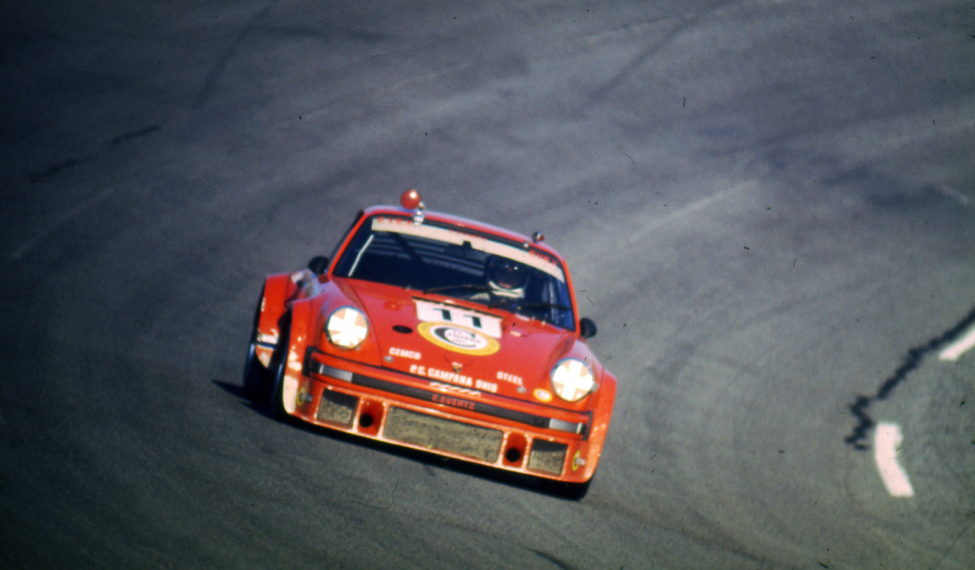 The first turbocharged Porsche 934 ever to race anywhere in the world was at the 24 Hours of Daytona in January 1976, eligible only by special invitation to the World Championship of Makes Manufacturer championship. It finished forty-first, dropping out with mechanical issues. Photo credit: autosportsltd.com
The first turbocharged Porsche 934 ever to race anywhere in the world was at the 24 Hours of Daytona in January 1976, eligible only by special invitation to the World Championship of Makes Manufacturer championship. It finished forty-first, dropping out with mechanical issues. Photo credit: autosportsltd.com
But once the announcement was made, feedback from competitors was swift and largely negative. “When the 934 was announced, I spent time canvassing the paddock at our next event and with few exceptions the sentiment was against letting the 934 run,” recalled Bishop. “The biggest concern was cost. Not only was the car more expensive than a Carrera RSR, racing versions of the electronics and engine management systems for turbos were not yet well established, nor our ability to regulate boost pressure. And the recent memory of the destruction of the “classic” Can-Am by turbocharging made everyone understandably wary.”
“The only two in favor of the change were Peter Gregg and Al Holbert, both of whom owned Porsche dealerships and stood to gain the most in terms of competitive advantage since they were Porsche’s de facto factory teams. So, I had to call Jo Hoppen back and rescind our approval. He wasn’t too happy about that.”
In fact, Hoppen was hopping mad. He had already taken 11 pre-orders for Porsche 934s from many of the top Camel GT teams who were at that time racing Carrera RSRs. In retaliation, he called the SCCA and lobbied for the cars to be included in the 1976 Trans-Am series, which had been suffering from dwindling grids and reduced public interest. Hoppen guaranteed he could provide entries for the series and the Club readily agreed to create a special Category II class for the cars, which began in 1976. Driving a Porsche 934, George Follmer went on to win the 1976 Trans-Am championship.
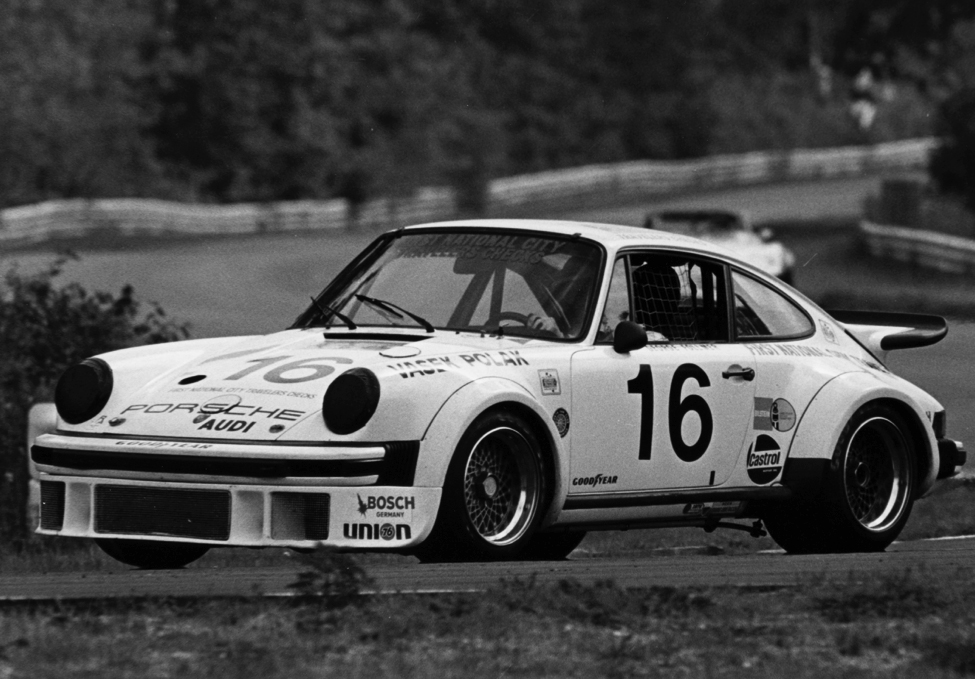 George Follmer won the 1976 Trans-Am Class II championship driving this Porsche 934, pictured here at Road America. Photo credit: International Motor Racing Research Center.
George Follmer won the 1976 Trans-Am Class II championship driving this Porsche 934, pictured here at Road America. Photo credit: International Motor Racing Research Center.
Ultimately, the pressure from Porsche headquarters in Germany to accept the 934 became too much for IMSA to resist. While dominating the Trans-Am series was a feather in Porsche’s cap, the real prize was considered the more popular IMSA series and Porsche wanted back in with its state-of-the-art cars. The 934 was finally accepted in the middle of the 1976 season, with one car from Holbert’s shop and another from Paul Miller fielded at the Mid-Ohio 6-Hours in late August in the hands of Doc Bundy and George Follmer (they finished 14th) and Milt Minter and Paul Miller (they finished 20th). All were regular Trans-Am competitors at the time.
The Porsche 934 appeared a few more times in the 1976 season with modest results, including a couple of podiums for Haywood at Laguna Seca and Danny Ongais for the new Interscope Racing team at the Daytona finale. However, the car was ultimately uncompetitive in the Camel GT Series given the narrow tires, relatively high FIA Group 4 weight limit and severe turbo lag. But the door was now wide open and there was no going back: the turbo era in IMSA had officially begun.
The 1977 season was much anticipated, given the rules changes announced the previous fall. Turbocharged Porsches and the new turbocharged BMW 320i would be mixing it up with AAGT muscle. The more relaxed FIA Group 5 rules concerning bodywork and tires added an exotic look to the series. A blending of FIA Group 4 and Group 5 rules meant that there was no early consensus on the right package for the year, which turned out to be the DeKon Monza again in the hands of Al Holbert and others.
The impasse between IMSA and Porsche in 1975 over the 934 had now evolved into a new wave of cooperation. Negotiations in the fall of 1976 introduced the Porsche 934 and a half for the 1977 season, otherwise known as the 934/5. The car fixed some of the technical issues of the 934 making it very competitive. It was the first Porsche produced specifically for IMSA competition. The truce would turn out to be instrumental in bringing the turbo era to IMSA, which shaped the Camel GT Series for nearly a decade.
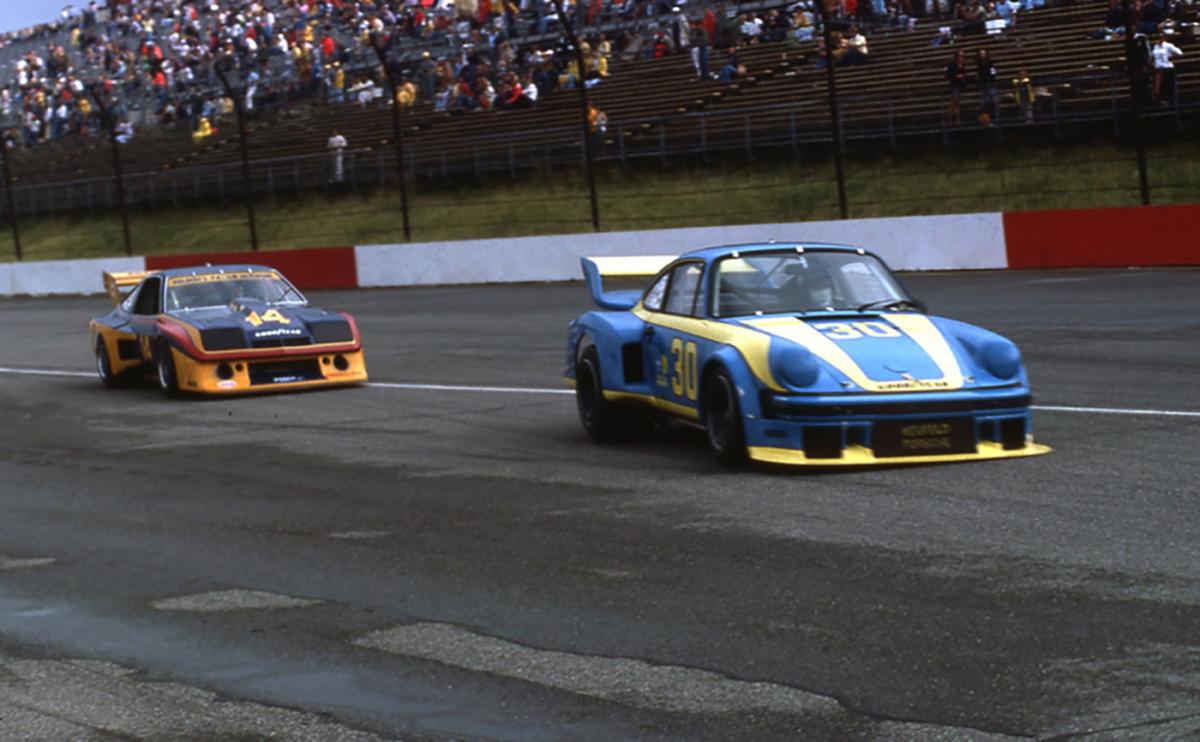 George Dyer’s Porsche 934/5 leads the way for Al Holbert’s AAGT Monza at Pocono in 1997. Note the larger fender flares, rear wing and tires of the 934/5 when compared with the “standard” 934 from the previous year. Photo credit: Bruce Czaja
George Dyer’s Porsche 934/5 leads the way for Al Holbert’s AAGT Monza at Pocono in 1997. Note the larger fender flares, rear wing and tires of the 934/5 when compared with the “standard” 934 from the previous year. Photo credit: Bruce Czaja
The 934/5 was a derivation of the 934 but included some key FIA Group 5 upgrades, including wider wheels and fender flares, updated fuel injection producing 55 more horsepower, 45 kilos less weight and a larger FIA specification Group 5 rear wing. A total of ten would be built but not all would be ready for the early endurances races at Daytona and Sebring. Although two of the cars would end up in the Trans-Am, nine were quickly sold to Porsche customers for IMSA racing, including Peter Gregg, George Dyer, Ted Field, Jim Busby, Vasek Polak, Bob Hagestad, Ludwig Heimrath and newcomer Dick Barbour.
The first Camel GT sprint race of the 1977 season at Road Atlanta in April saw Porsche 934/5s arrive in full force with six of the cars sold to North American teams on the starting grid. Gregg returned to the Porsche camp for 1977, but his version of the 934/5 was found to be out of compliance. He had added a full Porsche 935 (as yet not legal in IMSA) rear suspension and lowered the overall height of the car, resulting in bodywork changes that were also not permitted.
These changes were clearly outside the agreement between IMSA and the Porsche factory, so Gregg was turned away at the Road Atlanta pre-event technical inspection. In a huff, he immediately left the Camel GT Series to compete instead in the Trans-Am in 1977. He went on to win the Trans-Am championship in the same car, or so it seemed. After the season finale, Gregg lost, won and then lost that championship again in the FIA court of appeal system to Canadian Ludwig Heimrath. Multiple protests by the other competitors of the Brumos 934/5 configuration during the year were eventually upheld by the FIA in the postseason and Heimrath was named the champion.
Stay tuned for more excerpts from our upcoming book, IMSA: 1969-1989, available now for presale!
Although the 1975 Camel GT season was once again dominated by the Porsche Carrera RSR, it marked an important turning point for the growing IMSA series. Factory-backed BMW CSLs were campaigned by pilots Brian Redman, Hans Stuck, Ronnie Peterson, Dieter Quester and Sam Posey. All-American GT Monzas from DeKon and others began showing up, further diversifying the grid. And a fight over turbos erupted that wasn’t really settled until the following year. Here’s the inside story of how that battle went down.
(Banner image: Doc Bundy’s Porsche 934 in front of Jim Busby’s Porsche Carrera RSR at Mid-Ohio in August 1976. Photo credit: autosportsltd.com)
The 1975 Camel GT season had its share of controversy. In July, Jo Hoppen (head of Porsche Motorsports North America) announced that Porsche’s customer car for the following year would be the new turbo-powered 934, developed specifically to FIA group 4 regulations from the potent street 911/930 turbo road cars. Initially, John Bishop and IMSA agreed to let the new Porsche run. Turbos were not new in racing. In fact, the worldwide introduction of high performance road cars using small displacement turbocharged engines was a logical result of the recent international energy crisis. The thinking by Porsche and IMSA was that the Camel GT Series should reflect what was happening with road cars.
 The first turbocharged Porsche 934 ever to race anywhere in the world was at the 24 Hours of Daytona in January 1976, eligible only by special invitation to the World Championship of Makes Manufacturer championship. It finished forty-first, dropping out with mechanical issues. Photo credit: autosportsltd.com
The first turbocharged Porsche 934 ever to race anywhere in the world was at the 24 Hours of Daytona in January 1976, eligible only by special invitation to the World Championship of Makes Manufacturer championship. It finished forty-first, dropping out with mechanical issues. Photo credit: autosportsltd.comBut once the announcement was made, feedback from competitors was swift and largely negative. “When the 934 was announced, I spent time canvassing the paddock at our next event and with few exceptions the sentiment was against letting the 934 run,” recalled Bishop. “The biggest concern was cost. Not only was the car more expensive than a Carrera RSR, racing versions of the electronics and engine management systems for turbos were not yet well established, nor our ability to regulate boost pressure. And the recent memory of the destruction of the “classic” Can-Am by turbocharging made everyone understandably wary.”
“The only two in favor of the change were Peter Gregg and Al Holbert, both of whom owned Porsche dealerships and stood to gain the most in terms of competitive advantage since they were Porsche’s de facto factory teams. So, I had to call Jo Hoppen back and rescind our approval. He wasn’t too happy about that.”
In fact, Hoppen was hopping mad. He had already taken 11 pre-orders for Porsche 934s from many of the top Camel GT teams who were at that time racing Carrera RSRs. In retaliation, he called the SCCA and lobbied for the cars to be included in the 1976 Trans-Am series, which had been suffering from dwindling grids and reduced public interest. Hoppen guaranteed he could provide entries for the series and the Club readily agreed to create a special Category II class for the cars, which began in 1976. Driving a Porsche 934, George Follmer went on to win the 1976 Trans-Am championship.
 George Follmer won the 1976 Trans-Am Class II championship driving this Porsche 934, pictured here at Road America. Photo credit: International Motor Racing Research Center.
George Follmer won the 1976 Trans-Am Class II championship driving this Porsche 934, pictured here at Road America. Photo credit: International Motor Racing Research Center.Ultimately, the pressure from Porsche headquarters in Germany to accept the 934 became too much for IMSA to resist. While dominating the Trans-Am series was a feather in Porsche’s cap, the real prize was considered the more popular IMSA series and Porsche wanted back in with its state-of-the-art cars. The 934 was finally accepted in the middle of the 1976 season, with one car from Holbert’s shop and another from Paul Miller fielded at the Mid-Ohio 6-Hours in late August in the hands of Doc Bundy and George Follmer (they finished 14th) and Milt Minter and Paul Miller (they finished 20th). All were regular Trans-Am competitors at the time.
The Porsche 934 appeared a few more times in the 1976 season with modest results, including a couple of podiums for Haywood at Laguna Seca and Danny Ongais for the new Interscope Racing team at the Daytona finale. However, the car was ultimately uncompetitive in the Camel GT Series given the narrow tires, relatively high FIA Group 4 weight limit and severe turbo lag. But the door was now wide open and there was no going back: the turbo era in IMSA had officially begun.
The 1977 season was much anticipated, given the rules changes announced the previous fall. Turbocharged Porsches and the new turbocharged BMW 320i would be mixing it up with AAGT muscle. The more relaxed FIA Group 5 rules concerning bodywork and tires added an exotic look to the series. A blending of FIA Group 4 and Group 5 rules meant that there was no early consensus on the right package for the year, which turned out to be the DeKon Monza again in the hands of Al Holbert and others.
The impasse between IMSA and Porsche in 1975 over the 934 had now evolved into a new wave of cooperation. Negotiations in the fall of 1976 introduced the Porsche 934 and a half for the 1977 season, otherwise known as the 934/5. The car fixed some of the technical issues of the 934 making it very competitive. It was the first Porsche produced specifically for IMSA competition. The truce would turn out to be instrumental in bringing the turbo era to IMSA, which shaped the Camel GT Series for nearly a decade.
 George Dyer’s Porsche 934/5 leads the way for Al Holbert’s AAGT Monza at Pocono in 1997. Note the larger fender flares, rear wing and tires of the 934/5 when compared with the “standard” 934 from the previous year. Photo credit: Bruce Czaja
George Dyer’s Porsche 934/5 leads the way for Al Holbert’s AAGT Monza at Pocono in 1997. Note the larger fender flares, rear wing and tires of the 934/5 when compared with the “standard” 934 from the previous year. Photo credit: Bruce CzajaThe 934/5 was a derivation of the 934 but included some key FIA Group 5 upgrades, including wider wheels and fender flares, updated fuel injection producing 55 more horsepower, 45 kilos less weight and a larger FIA specification Group 5 rear wing. A total of ten would be built but not all would be ready for the early endurances races at Daytona and Sebring. Although two of the cars would end up in the Trans-Am, nine were quickly sold to Porsche customers for IMSA racing, including Peter Gregg, George Dyer, Ted Field, Jim Busby, Vasek Polak, Bob Hagestad, Ludwig Heimrath and newcomer Dick Barbour.
The first Camel GT sprint race of the 1977 season at Road Atlanta in April saw Porsche 934/5s arrive in full force with six of the cars sold to North American teams on the starting grid. Gregg returned to the Porsche camp for 1977, but his version of the 934/5 was found to be out of compliance. He had added a full Porsche 935 (as yet not legal in IMSA) rear suspension and lowered the overall height of the car, resulting in bodywork changes that were also not permitted.
These changes were clearly outside the agreement between IMSA and the Porsche factory, so Gregg was turned away at the Road Atlanta pre-event technical inspection. In a huff, he immediately left the Camel GT Series to compete instead in the Trans-Am in 1977. He went on to win the Trans-Am championship in the same car, or so it seemed. After the season finale, Gregg lost, won and then lost that championship again in the FIA court of appeal system to Canadian Ludwig Heimrath. Multiple protests by the other competitors of the Brumos 934/5 configuration during the year were eventually upheld by the FIA in the postseason and Heimrath was named the champion.
Stay tuned for more excerpts from our upcoming book, IMSA: 1969-1989, available now for presale!


